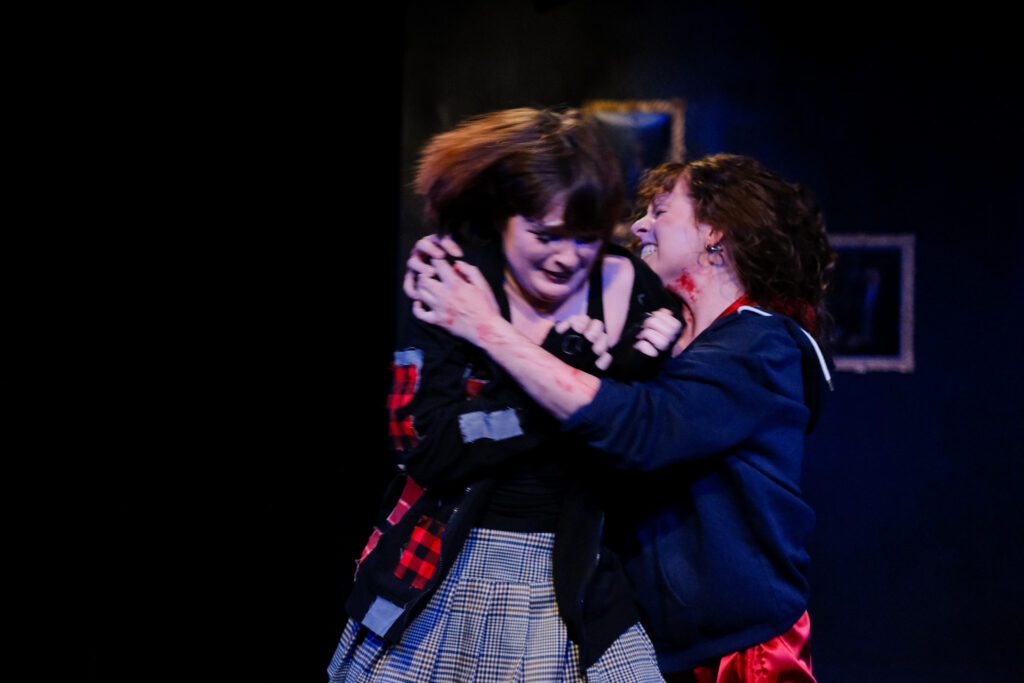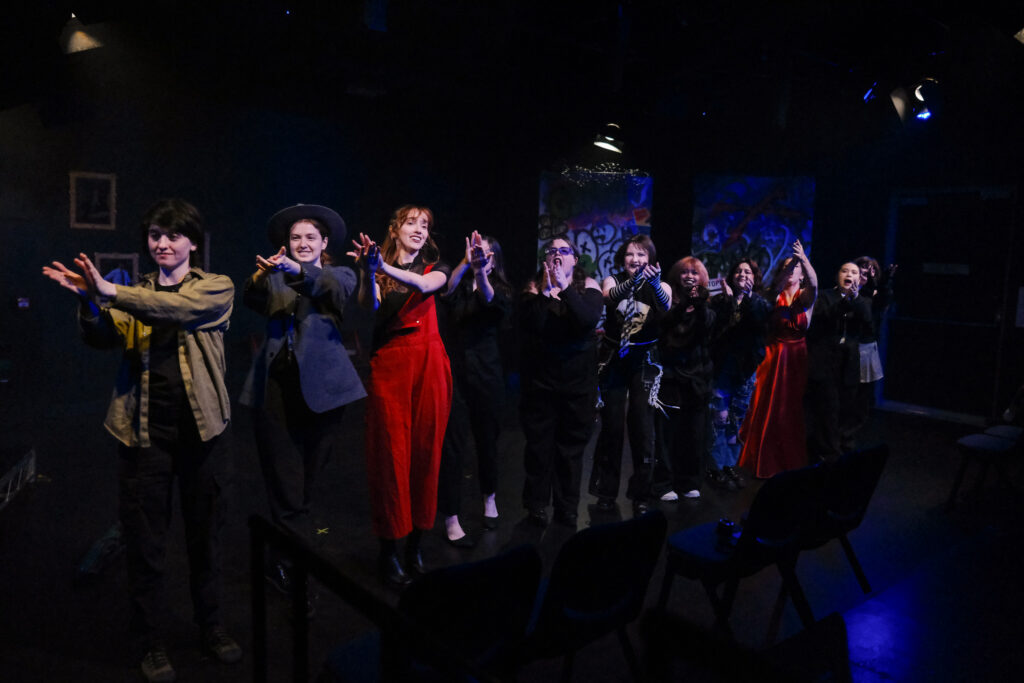Kill Climate Deniers — Review
ATYP’s reviewing program was created to give young people a platform to voice their opinions and experiences while developing skills in critical reflection. The views expressed are those of the writer and do not reflect the views of ATYP or its staff.
 Scout McWhinney & Sophie Burrows in Kill Climate Deniers, 2024, Photo by Dom Young – UNSW NUTS
Scout McWhinney & Sophie Burrows in Kill Climate Deniers, 2024, Photo by Dom Young – UNSW NUTS
NUTS’ 2024 production of David Finnigan’s ‘Kill Climate Deniers’ is everything you would expect (and love) from its radical title. It’s evocative; it’s punk; it’s passionate; it’s intense. But, most importantly, it’s vulnerable: an open conversation between Finnigan and the multiple sides of the climate debate. And while it can be too messy at times, this production is exceptional at understanding why the play’s vulnerability is its most radical idea.
Finnigan’s play has had an extensive history with student theatre since its original 2017 production. And it’s not hard to see why. On the surface, it is a black comedy, pro-climate change piece. It follows a group of fictional eco-terrorists that take siege of Australia’s parliament, holding politicians and journalists hostage until a solution for climate change is implemented. But, beneath all this is a dialogue, the central conflict of the play, between the playwright himself and the audience––the Australian people. It is raw and right in your face, which student theatre tends to also be.
It is no surprise then that directors Ana Dougenis and Zoe Berg have put the rawness of the play at the forefront. Almost every directorial element is constructed in a way that facilitates and energises the dialogue. A particular highlight for me were the scenes where the cast swarmed the space while delivering comments Finnigan had received from climate deniers. The cast would often duck and weave between each other effortlessly in a circular motion, as if they were buzzing and relentless flies.
Props also must be given to fight coordinator Jay Rushwood and fight captain Gaby Whalland. Rushwood’s choreography is delightful and action-packed, especially during fights where the characters wrestle each other. It’s dirty, messy, and violent in all the right ways. Whalland having to cement these moments 30 minutes before each show night, I imagine, is no easy task!
Despite the focus on movement, Dougenis and Berg also tone down the chaos in select scenes. These moments of downtime include cine-theatre parodying relatable and still relevant Australian politics; documentary-theatre styled bits satirising direct quotes from real people and contextualising them in comedic work done by the talented and funny ensemble (Charlie Thomson, Eleanor Watson, Lucy Gray, Ines Sicard, and Shai Kristen); and direct talks with David Finnigan (Soren Goulding) as either observer or mediator, effectively bridging the gap, constructing communication, between reality and fiction.
In fact, it was these moments with Finnigan that captivated me the most. It is incredibly easy for an actor to come across as self-indulgent and pretentious when playing the playwright’s self-insert. But Goulding embodies Finnigan’s pseudo-meta narrator position in a manner so skilful that it surprised me. Rather than coming across self-indulgent, they come across critical and constructive. Rather than coming across pretentious, they come across humble. Goulding’s expression and delivery shared a level of respect with the audience that never disappears. Their approach to their role got me completely onboard with Finnigan’s dissections in the play.
 Soren Goulding, Eleanor Watson, Lucy Gray, Ines S. L, Jasmin Schofield, Charlie Thomson, Shai Kirsten, Abigail Pierce, Sophie Burrows, Eliza Hoh & Scout McWhinney , 2024, Photo by Dom Young – UNSW NUTS
Soren Goulding, Eleanor Watson, Lucy Gray, Ines S. L, Jasmin Schofield, Charlie Thomson, Shai Kirsten, Abigail Pierce, Sophie Burrows, Eliza Hoh & Scout McWhinney , 2024, Photo by Dom Young – UNSW NUTS
In Catch’s big scene, the exemption of the audience as hostages in the parliament house was confusing. I found most decisions in the play centred around breaking boundaries between audience and play, so to leave out the audience at its highest tension moment felt like a missed opportunity.
A very honourable mention should also go out to Sophie Burrows as Gwen Malkin and Eliza Hoh as Georgina Bekken. The duo were both expressive actresses who had a very strong sense of comedy and played off each other well. I particularly enjoyed Burrows’ facial expressions and Hoh’s ridiculously funny comedic timing. The two were great parodies of Australian politicians and played into Finnigan’s shamelessly tongue-and-cheek humour.
The overall aesthetic created by lead designer Trinity Ray strengthened the stripped back moments more than it did the animated ones. For instance, the minimalist set approach by set designers Hailie Brown and David Thane involved few things. Two flats littered in graffiti, pictures of Australian prime ministers framed to the wall (which hilariously change to Catch’s face once the eco-terrorists take over), and defaced posters across the stage. Less is more in this case, where the set is enough to create a rebellious atmosphere, while also leaving effective space for the actors to have their dialogue with the audience. Nonetheless, more posters across the theatre could have improved the atmosphere even more.
‘Kill Climate Deniers’ presented by NUTS can be summarised by its best scene. Halfway through act 2, there is a multi-layered dialogue happening between Catch, Finnigan, and Beverly Ile (Lucy Gray). The conversation between McWhinney and Gray are representations of conflicting sides of the climate debate. There is a hatred for both and the scientists, before McWhinney shoots Gray in the back of the head. Goulding, rather than shooting down the media’s shifting of accountability, exclaims that they “hate scientists.” This comment becomes significant when you have the context that Finnigan himself works with climate scientists.
It is then obvious that Finnigan’s play is a conversation with himself. Where his characters are mouthpieces for his conversations about climate change and are literally shot down one-by-one. It is raw and right in your face, it is vulnerable. It is not seeking to demonise climate deniers, instead it engages them. As such, Dougenis and Berg allow the audience to be engaged by the play. Facilitating a production that, while is messy or muddled sometimes, understands that Finnigan’s vulnerability is what can progress the climate debate.
★★★★
— Aidan Hale

